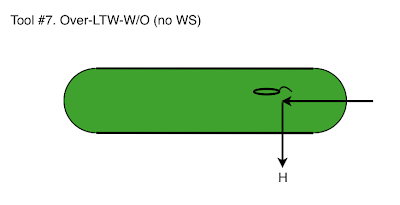- Series A. At Cheltenham, attempting work on land-water-land (LWL) retrieves at north end of large pond, Eric throwing (Laddie)
- Series B. At Cheltenham, cheaters at north end of large pond, Eric throwing (Lumi)
- Series C. At Cheltenham, more work on LWS at west channel, Eric videotaping (Laddie)
- Series D. At Black Hill Regional Park, come-in drill (both dogs)
For Series A, I set up with Laddie along the pond's north shoreline on the right side of the T-shaped peninsula, and I asked Eric to throw for us from the right point of the peninsula. The distance from the SL to the falls was about 30 yards.
We started with a throw into open water not far from the point. Laddie had no problem with that.
Next, I asked Eric to throw into the water right at the shoreline. Laddie swam straight to the dummy, and it was good that he did not attempt to run the bank to get to the dummy. But when he reached the dummy, he picked it up and carried onto shore, shook off, and then tried to run back to me on the peninsula. At my request, Eric blocked him and eventually threw the dummy back into the water, and then Laddie jumped in, picked up the dummy, and swam back to me to deliver the dummy.
We tried the same throw a couple of more times, with identical results. I then put Laddie in the van so that I could work with Lumi.
Series B. I had Lumi run three cheating singles at this location:
- On the right side of the T-shaped peninula, 30 yards from SL to shoreline, 20 yards from shoreline to fall in open water. The line from SL to fall ran less than 10 yards to the right of the peninsula.
- On the left side of the peninsula, 30 yards from SL to shoreline, 40 yards from shoreline to fall on the left point. The line from SL to fall ran less than 10 yards to the left of the peninsula.
- Same as #2.
- Lumi had no problem on #1.
- On #2, Lumi veered right with apparent intention of running the bank. She was not responsive to handling into water from my initial SL, so I moved 20 yards closer and sent her to the same fall. Lumi again attempted to run bank, but accepted handling into water and ran the mark nicely.
- On #3, we started at the long SL again, and this time Lumi ran the mark without difficulty.
In the past, I ran Laddie across the channel east to west, toward the woods, and he seemed to be spooked by the woods. So today, I ran him at the same location, but west to east.
We worked thru several phases, with mixed results. Here's a video of the session, videotaped for us by Eric:
Series D. To continue strengthening the dogs responsiveness to Here for use with partial come-ins when running blinds, I set up a simple course with four lining poles and no dummies in an isolated area of the Black Hill Regional Park. I used one of the poles as an SL and placed the three other poles at 60-40-80 yards left to right, within a 90° angle. All the target poles were at treeline of an adjoining woods, and various diversions and obstacles, such as trees, a trench, and a high fence were in the dogs' line of vision.
I ran Laddie first, then Lumi. In both cases, we ran the "blinds" in the order middle-left-right, that is, shortest to longest. For each "blind", I sent the dog to the target lining pole, and when the dog arrived, I blew WS, then cued Here. When the dog arrived back at the SL, I reinforced with praise and a high-value treat.
LADDIE
On every "blind", Laddie responded beautifully to every WS, but refused one or more Here cues. When he broke in the wrong direction, I blew another WS immediately, then again cued Here. The longer the distance, the more times it took for Laddie to respond to Here correctly. On the 80-yard retrieve, he refused three times, then came in on the fourth.
LUMI
Lumi came immediately and on the run on the 40-yard and 60-yard "blinds". On the 80-yard one, she responded well to the WS but broke to the side when I cued Here. I quickly blew WS and cued Here again, and this time she came running.



